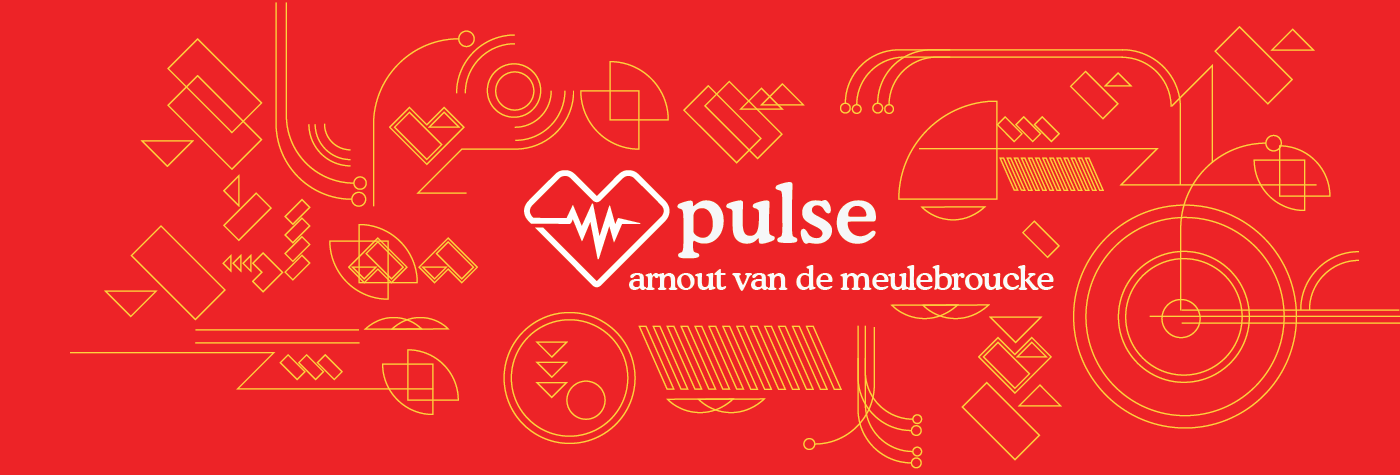As the founder of madewithlove, I am always looking for ways to improve our company and culture. Recently, I had the opportunity to sit down with Leslie Carr, the head of engineering at Pando, to discuss two important topics: giving feedback and employee lifetime value. Welcome to a new episode of Pulse, the lifeblood of the SaaS software industry!
Episode 10 – Employee lifetime value
Feedback is an essential aspect of personal and professional growth and development. At madewithlove, we have a culture of continuous feedback where everyone, regardless of their position, is encouraged to give and receive feedback regularly. Leslie and I discussed the importance of feedback and how to provide it in a constructive manner. We also discussed the challenges that come with receiving feedback and how to address them effectively.
Listen to the podcast on your favorite platform
- Episode 10 on Anchor.FM
We also discuss Employee lifetime value (ELV). ELV refers to the total value an employee brings to a company during their tenure. It includes their contributions to the company and their potential for growth and development. Leslie shared some interesting insights on how to measure and increase ELV, including the importance of investing in employee development and providing opportunities for career advancement.
What is Employee Lifetime Value?
ELV is important for companies because it helps them to understand the long-term impact of investing in their employees. By calculating ELV, companies can assess the return on investment (ROI) of employee training and development programs and other initiatives designed to improve employee engagement and retention.
ELV can also be used as a tool for employee retention and motivation. By providing opportunities for career growth and development, companies can increase an employee’s ELV and encourage them to stay with the company for the long term. This is beneficial because it can reduce the costs associated with employee turnover and recruitment and help build a more skilled and experienced workforce.
Invest in creating a feedback culture
I believe that it is essential to invest in our employees and provide them with the support and resources they need to succeed. You do not need to spend a lot of money; building your own little feedback tool in Slack or via Google Forms can do wonders. Or install Feedback Fridays, as Leslie does.
Listen to the podcast episode.
Here is a transcript of this episode
Hi, I’m Andreas. I’m the founder and CEO of madewithlove. We help startups and teams grow. Today I’m talking for about 15 minutes with Leslie Carr, head of engineering at Pando, about the employee lifetime value in Pulse, our monthly podcast. Grab a cup of coffee, sit back, and enjoy.
Today I’m talking with Leslie from Indiana, United States. She currently lives in San Francisco. She worked at Google, Craigslist, and Twitter and ended up at Slack before she joined Pando. Welcome to the podcast, Leslie.
Thanks. It’s really great to be here.
Cool. Yeah, it’s, uh, it’s nice, so you worked in a lot of different companies, um, and I didn’t even mention all of them. For example, Wikimedia was not on the list, and Clover Health. Um, but what surprised me is that you moved from Slack, which is a huge organization, obviously, to a very small team like Pando with just 16 people. As a head of engineering, obviously it must have been a big change. What was your motivation for jumping ship?
Yeah, I felt like I was stagnating a little bit at Slack, and it was funny, just really funny timing. Um, I think it was on a Tuesday, I decided maybe I’ll look around for other companies. And on that Thursday, I get a message on LinkedIn from Barbra, the founder of Pando. Uh, I had actually worked with her husband previously on an open-source project.
And so that’s why, you know, usually when you get those LinkedIn messages, you delete them. But that’s why I was like, I’ll talk to this person. Why not? Why not just, you know, see what’s going on? Even though at the time I thought Pando was five people, and in my head, I’d had decided, no, it’s way too small.
But as soon as Barb showed me the product, I was just wowed. Um, As a manager and leader, I think one of the most important things I can do is give good feedback to my reports. It’s one of my most important job duties. Mm-hmm. And I think that feedbacks and reviews and all of that are something that a lot of companies do really poorly.
It’s hard and there’s no real training for it. I’ve been trying to convince all of my reports and all my managers that it’s very important to give really specific feedback and give feedback that’s really related to the job ladder, but it’s not really enforced. Um, as soon as Barbra showed me, Pando, I was like, this is how I think we need to be giving feedback, and we need to be doing reviews. Uh, Pando really focuses everything on the job ladder, and you know, I come from an infrastructure background as an engineer. And so in infrastructure, I think it’s really important that you use tooling to get people to do the right thing.
For example, you want people to, do all of your automated testing on your deployment pipeline; well, you better make that deployment system really easy to use, or else people are just gonna push code and bypass all those tests. So I think it’s the same thing. You know, people are just really, really complicated systems, right?
So you need to have a well-designed tool. You know the focus is on feedback and reviews to get all of your managers to do the right thing in giving good feedback to their reports.
Makes sense, and how, I mean, how frequently do you believe or does Pando enforce a frequency in the feedback or is it something that you can decide yourself or how do you see it?
Oh, we don’t enforce a frequency. I personally sort of enforce, I do feedback Fridays, so I always find some fun gif post up on the general channel and encourage folks, you know, to take 15 minutes and just write someone feedback, right? It can be your peer; it can. be your report, it can be your manager. Just something. I think having that time set aside makes it into a habit, right? And then, once you have the habit, it’s a lot easier to keep going.
Yeah. And I mean, there is, of course, a difference, or we at least make a difference, between like really planned feedback and just like the feedback you’re mentioning like a shout-out. We always say like, if there is any feedback, you have to give it instantly. I think that’s, that’s very important. But also we have this kind of very formal feedback clip as well where we, in our team, I think every six months we have like we call a semester review, we basically have like really questionnaire people have to fill out and we go over it together. Do you combine those two, or is Pando like a hybrid system in between those?
Oh, both of those are separate, but I sort of think of it as that instantaneous feedback, and that, you know, less formal, more often, feedback feeds into your larger six-month reviews. Right? I think it’s especially important to have that feedback because, you know, as humans, we tend to forget things that happened, so I’m not gonna remember what happened six months ago as well as I remember what happened last month. But if I have that feedback and all that information from six months ago, I’m able to incorporate it better, and then you can, then you can sort of see more trends and you can see growth, and you can give someone just more comprehensive, formal feedback.
That makes sense. Yeah, I mean, you’re preaching to the choir here in terms of giving feedback, but in a lot of the clients that we are working with, and especially the ones that we audited in our due diligence process, they often say they’re too small to have like good feedback. I mean, at Pando, you’re also pretty small. I mean, 16 people, you’re doing it properly as well.
What’s your answer to that kind of claim from people when they say they’re too small to do proper reviews, for example?
Well, I have to wonder about that. So one of my first major company jobs was at Google, and Google is pretty infamous for having an incredibly horrible, painful feedback season called PERF. It basically is this whole three-month thing that happens twice a year.
And if you come from Google and think of that as how you give feedback, you don’t have time for that, right? You can’t take six out of your 12 months every year, or else your startup will fail. But that doesn’t mean that people don’t need feedback, and it doesn’t mean that feedback isn’t important.
You need to find out how to do lighter weight easier, more like small constant check-ins that can lead to some larger, you know, annual feedbacks or semi-annual feedbacks.
And so also when you’re at a larger company, you have the time for someone to not do their best. But when you’re at a small company, we have seven engineers; for example, on my team, I don’t have time for anyone to not be performing at their best. They have to be doing as well as they possibly could, and feedback is how I help them to grow and how I help them to make sure that they’re doing their best work.
Yeah, sure. I think most of the cases we see it is because managers are too busy to make the time to give proper feedback. And they’re kind of ignorant of the issues that they have in the team. And they think if I don’t give the feedback, the team is just functioning okay-ish.
That’s how I see it most of the time. And it’s very frustrating also to see that people don’t realize that giving proper feedback really helps the team to grow. Maybe it’s more a European thing, but we give a lot of negative feedback; there is a saying that you need for each point of negative feedback, you need 20 positive points of feedback, and that’s kind of the ratio that it should be. I don’t know if that’s maybe exaggerating, but
I think; you also brought up a really good point about positive feedback. Even if, let’s say, your team is doing amazingly right? Everyone is just doing so well. You’re, you’re, you’re amazed. When people join small startups, they really want to see their impact, right? You join a small startup. Because you wanna see that you’re doing a good job and that you’re helping everything go. And giving that positive feedback is a way for someone to feel recognized. You want all of your employees to realize, I am doing a great job when they’re doing a great job.
I find a lot of good engineers actually don’t realize how good of a job they’re doing. And you know, even if you are saying you’re doing everything perfectly, tell them that also. Because if you don’t, they aren’t gonna feel as appreciated. They aren’t going to be demotivated. And then they might go to another startup. You know, when you have something like seven engineers, every engineer has so much knowledge about the product, I don’t wanna lose a single one.
Yeah, of course. That’s something that, you as Pando, I guess, or at least Barbara, put into a very nice term, which you call employee lifetime value.
I think that’s, that’s very interesting. It’s something that we mention to all investors that we’re working with, like, if you can shorten the onboarding time of an employee and have as much as productive time as possible of an employee in the team, and also reduce the kind of slacking time that they have when they’re about to quit, of course, the actual value gets from the employee increases a lot. And how does your tool help with that? I mean, does it help with that? I don’t know.
Definitely, so yeah, as engineers, we often think about the engineering onboarding, like how long does it take till somebody really knows your code base? But you could also think about like the employee’s lifetime value as just how long until someone is their maximum productive self. Like I think giving that regular feedback sort of can help increase someone’s productivity and increase their performance level. And so if you think of it sort of as a chart, right? You know, with the y access being units of work and X access being time, well, anytime you can, you know, increase the angle, and so you’re going up on the y access more quickly, that increases all of that area.
Aka, you’re getting more work done. You want people to be always growing and always being more productive. You know, when someone’s a junior engineer, growth might mean: you know, Python better and you know, all of these things. But as a senior engineer, growth might be you are designing the right level of redundancy in your data pipelines, for example, because, you know, may have gotten a great engineer who came from a very large company like Google again. They might be used to designing pipelines for, you know, terabytes and terabytes of data per second and you’re in a tiny startup, you have megabits per second. So maybe for them, growth is learning how to code a little less stringently and getting things out the door quicker. Yeah, exactly. So there’s always, there’s always growth you can do and growth, maybe just really more specific to your application.
Yeah, that makes sense. Yeah. That’s being pragmatic. It, I think it’s a lot of people struggle with that as well. To basically the task at hand. Um, we work exactly, I mean, we work for a very early stage startup, but also, like in scale-ups and our engineers really have to, with every project, we have to tell them, okay, this is the setting that you’re working in. Here, you can do it quicker dirty, here you have to do it perfectly. I think that that makes a little sense. And, I think one of the things that are very cool about what you guys are doing is that you also made this kind of rubric of all the different roles that there are with their, I dunno, how you call them. Um, let me think about it.
Competencies. Yeah, competencies, exactly. If I would start doing feedback like how you, um, imagine it and, actually, at madewithlove, we have made a system similar to that called Skills Map; we don’t really give feedback on it, but we map out the skillset of all our team members, and we really went on creating that rubric for ourselves. And we figured out how massive of a challenge it was, and we only have two roles in our team: a CTO in residence and a software engineer. But obviously, if you have more roles, it’s, it’s, uh, it’s a huge task and they’re taking, I think that really helps that you made those. And can you maybe explain a bit more, like how you, did you get there? Was it your research or did you try to figure out yourself or how do you know that?
Yeah. Um, there was, uh, in the beginning, there was a lot of research. Um, a lot of companies have their job ladders online in public, and so you can take all of those and sort of, you know, synthesize what’s common amongst all of those well-written job ladders. And we actually have since hired a woman who’s a, who has a Ph.D. in, um, basically in developing rubrics and competencies in large organizations. And so this is what she’s been studying for so many years. And so she’s great. Uh, she does a lot of interviewing as well as looking at research.
Uh, turns out a lot of business schools have a lot of research on job ladders. Like I never knew! Yeah. And then obviously feedback from internally as well as our customers. So it’s sort of, you know, like just as with a code base, job ladders are never done. You’re just always, you get them 80% of the way there, and then you’re just constantly tweaking and tweaking and tweaking.
Yeah, makes, makes sense. So let’s say you’re a very small startup and don’t do any feedback now. What would be your advice for them to get started with some kind of feedback loop? What would be the first thing you would want them to implement?
Start out with feedback fridays. I find a cool gif online. I post it on our Slack channel and say, sit down, take 15 minutes, and write feedback to someone. It doesn’t have to be good.
And it’s like you do that in person like you send it in person, or you send it in a general channel? The feedback itself.
Send it one-to-one. While positive feedback, definitely you can share more broadly. Even some people get a little embarrassed by even positive feedback being shared broadly and more constructive feedback, I feel like you should share a little more targeted just because you don’t want anyone to be taking it the wrong way.
Sure. So, yeah. So say, Hey look, just, just Slack someone that, right? Like, you don’t need any tools for that. If you wanna make it a little more formal and you don’t, you know, you don’t wanna spend any money on a tool like use Google Forms. Right. That’s free.
We actually, back in the days, wrote a tool for peer feedback as well, but we sunsetted it, and then we wrote a Slack app; you could ask someone for feedback, and then they would get the form pop up, and they would reply with the feedback in Slack. So you can do it with Slack automation, I think.
Yeah. Just do that. You can do something really low cost, really, really quick and casual, because you just have to practice. Right? Giving feedback is a skill. It’s gonna feel really awkward at first, so keep practicing that skill until it becomes second nature. I think that’s a very sensitive thing that you say there as well, that feedback, giving feedback, is a skill. I think that a lot of people don’t think to realize that, that it actually is. I think it’s something, that people do, but it’s not the case.
Definitely.
That’s it for today. Thanks a lot, Leslie, for your view on giving feedback. I think it’s a very, very interesting topic. I think I can talk for hours about it. I feel you can do the same. I think it’s very cool that you see companies innovate on how to give feedback because, as we just discussed, it’s something that, you still have to learn.
Um, lots of people do it very poorly, so any tool that they can use can improve how they give feedback that of course, helps. Uh, and, and I think you guys are also contributing to that with Pando. So thanks for doing that. Thanks for being on, on Pulse. Um, I hope you enjoyed it.
Thank you. This was great.
Awesome. So, it’s a wrap. Thanks for listening as well. See you next week or month. We’ll see how many episodes we make. And, uh, don’t forget to follow us on LinkedIn or via the website. And you can always reach out to us if you have any questions. For example, on giving feedback, we are there to help out.
See you next time. Ted’s the end of this episode. Thanks for listening and following us. Listen to other episodes on our website, madewithlove.com/pulse, or on your favorite streaming service. You can of course also follow us on LinkedIn or Twitter.
See you next time.











Member discussion